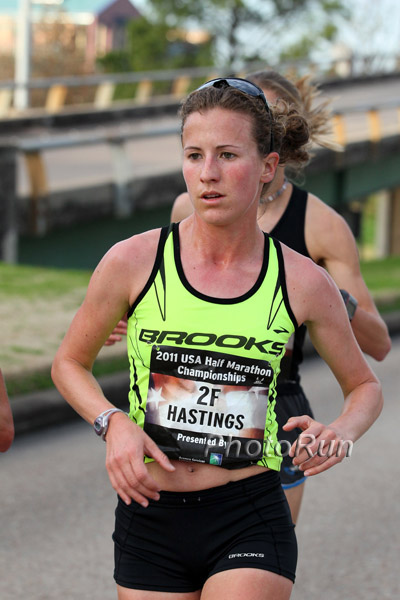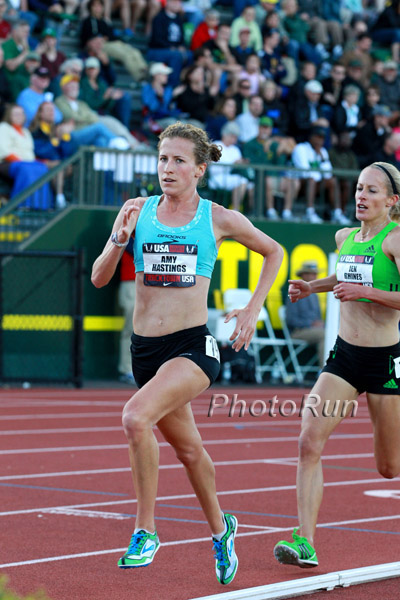 Amy Hastings, 2011 USA Half Marathon champs, photo by PhotoRun.net
Amy Hastings, 2011 USA Half Marathon champs, photo by PhotoRun.net
Lesley
Higgins, a former runner at the University of Colorado, and currently, a
steeplechaser running for the New York Athletic Club, had a
conversation with me about this issue early in 2011. This is a column
that we asked Ms. Higgins to write for RBR. Lesley has written several
pieces for us in the past and can be seen daily on the NYAC web site.
Updated September 22, 2011
Gender in Broadcasting, by Lesley Higgins
Back
in the 1980s and 90s, research was conducted on the equality of gender
in broadcasting. The research showed a discrepancy between the way men
and women’s events were covered. They found that men were routinely
referred to as “men,” yet women were often referred to as “girls.” They
also found that men were routinely referred to by their last names,
while women were often referred to by their first. Their reasoning for
this was that the hierarchy in our society results in those of higher
rank being addressed more by their last name, and the lesser members by
their first.
The sport of track and field offers a unique
opportunity for to observe a gender-split broadcast, where the same
announcers cover both men and women in the same time slot. So, I sat
down and watched archived video of track and field from this millennium
and paid attention to the same gender issues.
The broadcasters
had almost a perfect record of referring to women as “women,” and men as
“men.” Athlete’s first and last names, or last names only were
uniformly used. There were two instances of the word “girls,” but not so
much that it was an issue.
 Amy Hastings, Jenn Rhines, 2011 USA 5,000m, photo by PhotoRun.net
Amy Hastings, Jenn Rhines, 2011 USA 5,000m, photo by PhotoRun.netThere
was one glaring difference, though, between the college coverage and
the post-collegiate coverage. The college coverage was very to the
point, very on the topic of the sport for both genders. The coverage of
the 2008 Olympic Trials, however, was peppered with a lot of
human-interest stories that had absolutely nothing to do with the sport
of running. The stories covered during the 3000m steeplechase, for
example, were Anna Willard’s engagement, Anna Willard’s hair and Delilah
Decrescenzo attending the Grammy’s.
On
the men’s side, there were much fewer human-interest stories and the
most common had to do with naturalized citizenship, which is a relevant
topic, especially at the Olympic Trials. There were no discussions about
engagements, and rarely of children. The dialogue was consistent with
the sport of track and field.
Human-interest stories play an
interesting role in coverage of all sports. The point is to humanize the
athletes. The goal is to attract new fans, create loyal followings for
certain well-marketed athletes and inspire future generations of runners
to follow role models.
If this is the goal, then we need to
look at the way the men and women are being talked about and what topics
are appropriate to discuss. I would argue that what is appropriate is
not even necessarily the same for both genders. For example, the
implications of discussing the body weight, height and structure of the
different genders differ wildly.
It may seem balanced that a
discussion about the height and weight of Chris Solinsky in comparison
to his often-smaller 10,000m competitors is equivalent to the same
observations about a female athlete being larger than her competitors.
It is not.
It’s a fact that young girls are the most susceptible
subset to eating disorders. It’s also a fact that distance runners are
some of the most susceptible of any sport. If the goal of humanizing
athletes is to create loyal fans and a devoted following, discussions
about a female runner’s weight need to be left out of the discussion,
especially when it’s tied to performance.
The fact that I can
recall specific quotes about female athlete’s bodies years after they
were spoken is a testament to the power of making such associations. I
remember being shocked during a broadcast of the 2006 NYC Marathon when
one of the announcers make the statement that a local athlete was
clearly not built like a marathoner. This athlete was one of the biggest
talents to come out of the state, and the suggestion that the one thing
keeping her from competing with 2:30 marathoners was her size is
something that our future generations of runners do not need to hear.
Maybe
an athlete’s weight is relevant to the sport, but there are so many
more relevant things to talk about during a broadcast. For example: the
race. The conversation can be completely devoted to the race that is
going on, the tactics being employed and some interesting tidbits about
the athletes as it relates to the sport.
There is still a place
for human-interest stories, especially during marathon coverage where
the announcers have over two hours of airtime to fill. During track,
where often several hours of events are condensed down to an hour or
two, perhaps the conversation should stay more on point.
Author

Larry Eder has had a 52-year involvement in the sport of athletics. Larry has experienced the sport as an athlete, coach, magazine publisher, and now, journalist and blogger. His first article, on Don Bowden, America's first sub-4 minute miler, was published in RW in 1983. Larry has published several magazines on athletics, from American Athletics to the U.S. version of Spikes magazine. He currently manages the content and marketing development of the RunningNetwork, The Shoe Addicts, and RunBlogRun. Of RunBlogRun, his daily pilgrimage with the sport, Larry says: "I have to admit, I love traveling to far away meets, writing about the sport I love, and the athletes I respect, for my readers at runblogrun.com, the most of anything I have ever done, except, maybe running itself." Also does some updates for BBC Sports at key events, which he truly enjoys. Theme song: Greg Allman, " I'm no Angel."
View all posts




















